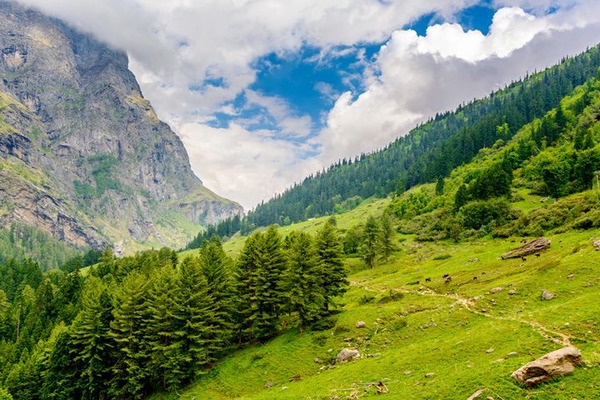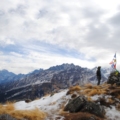My Wild, Soul-Stirring Adventure on the Pin Parvati Pass Trek

The moment my boots hit the rugged trails of Parvati Valley, I felt a surge of adrenaline. This wasn’t just a trek—it was a journey that tested my limits and left me in awe. I’ve led Explore Mountains through roaring rivers and snowy peaks, but Pin Parvati Pass? It’s in a league of its own. Grab a cup of chai, and let me walk you through every moment of this unforgettable adventure.
What Drew Me to Pin Parvati
This trek hooked me for a few reasons that still make my heart race:
- Views that stop you in your tracks: Picture standing amid the vast Pin River valley, with Chau Chau Kang Nilda peak towering above.
- Pure, untouched wilderness: No villages, just wildflowers, grazing cattle, and the wind singing through the valleys.
- A cultural tapestry: From Manikaran’s steaming hot springs to tiny shrines along the Parvati River that feel like secrets shared by the mountains.
- A challenge worth fighting for: Glacial snow, river crossings, and a climb to 19,524 feet—it’s tough, but the reward is pure magic.
My Day-by-Day Trekking Tale

Day 1: Manikaran to Kalga
I started in Manikaran, where the air smelled of sulfur from the hot springs. The trail wound downstream, pine trees scenting every breath, and the ground warm beneath my feet. By dusk, I reached Kalga, a tiny village that felt like a warm hug. Over crackling wood fires and steaming chai, I swapped stories with other trekkers, already buzzing for what lay ahead.
Day 2: Kalga to Pulga to Kheerganga
The second day was a rollercoaster—climbing through deodar forests so dense they blocked the sun, dipping down to the emerald glow of Pulga, then pushing up to Kheerganga’s misty plateau. Clouds swirled around me, and I felt the altitude tug at my lungs. That night, soaking in Kheerganga’s hot pools under the stars, I knew I was in deep.
Day 3: Kheerganga to Barshaini
A shorter day, but no less intense. The climb was steep, the descent sharper, and by the time I hit Barshaini, my legs were singing. I treated myself to a plate of spicy rajma-chawal at a local dhaba, savoring every bite while mentally gearing up for the real challenge: Pin Parvati itself.
Day 4: Barshaini to Thakur Kuan to Mantalai Lake
This day was all about the journey. I crossed wobbly wooden bridges over the Parvati River, its roar a constant companion. At Thakur Kuan, horses grazed in meadows that looked straight out of a painting. By evening, I pitched my tent beside Mantalai Lake, its icy waters reflecting a sky so full of stars I forgot how to blink.
Day 5: Mantalai to Pin Parvati Base to the Pass
This was the day that broke me and built me back up. The trail threw everything at me—glacial moraine, slippery river crossings, and switchbacks that seemed to never end. At the base camp, 16,250 feet up, the air was so thin it felt like breathing through a straw. But the thought of the pass kept me going, step after grueling step.
Day 6: Summit Day and Descent to Chatru
I dragged myself out of my sleeping bag at 3 AM, my headlamp cutting through the freezing dark. The summit ridge at dawn was unreal—pink light spilling over the snow like something out of a dream. Standing at 19,524 feet, I felt invincible. The descent to Chatru’s barren, moon-like landscape was a stark contrast, but I was too high on the summit to care.
Day 7: Chatru to Baralacha La to Tandi
The final leg was a love letter to the Himalayas. I crossed high plateaus, dodged waterfalls, and trudged through snowfields to reach Baralacha La. At Tandi, I collapsed by a campfire, masala chai in hand, swapping tales with locals who’d seen these mountains their whole lives. It felt like the perfect end.
Everything You Need to Know Before You Go
Tips to Nail Your Trek
- Take it slow: Spend at least two nights in Kheerganga or Barshaini to get used to the altitude. Trust me, your body will thank you.
- Guides and permits: You’ll need a permit from the IAS or Forest Department. A local guide isn’t just a safety net—they’re a window into the region’s heart.
- Solo or squad?: I’ve done solo treks, but a small group makes this one safer and way more fun.
Stay Safe Out There
- Weather is boss: High-altitude storms can hit hard and fast, so check forecasts.
- Snow-ready gear: Microspikes or an ice axe can save you on icy patches.
- Pack for survival: Altitude meds like Diamox, warm layers, and trekking poles are non-negotiable.
- Know the basics: Brush up on first aid for altitude sickness or frostbite—just in case.
When to Hit the Trail
- Late June to early September: The weather’s stable, and the trails are clear post-monsoon.
- Early October: It’s colder, snowier, and quieter—perfect if you want the mountains to yourself.
What to Pack and Where to Pause
Packing Essentials:
- A 4-season tent and a sleeping bag rated for –10°C (trust me, it gets chilly)
- Microspikes or crampons, plus trekking poles for stability
- Layers on layers: base, fleece, and a windproof/waterproof jacket
- High-energy snacks like nuts and energy bars to keep you going
- Sunscreen, sunglasses, and any personal meds
Must-See Spots:
- Dip in Manikaran’s hot springs
- Soak in Kheerganga’s cliffside hot pools
- Wander Mantalai’s alpine meadows
- Stand tall at Pin Parvati Pass (19,524 feet)
- Take in the sweeping views at Baralacha La
Let’s Fuel Your Mountain Dreams!
Is Pin Parvati calling your name? Drop your questions or share your own trekking stories in the comments—
Follow Destinatinguruji on Instagram and Facebook [@destinationguruji] for more travel stories and real-time updates.
For more visit my website :- exploremountains.com



